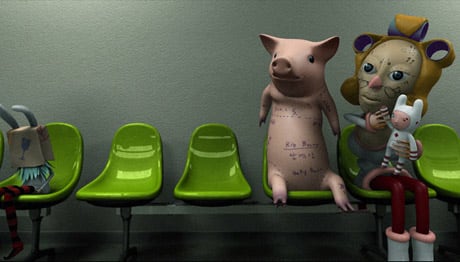A series of loosely tied together dramas, The New Social Sciences is one of the WWSFF's many attempts this season to draw parallels and connections between disparate short films.
The discomfort of the family-based melodramas New Media and Laura's Party may try the patience of some viewers, with little in the way of dramatic payoff for all the hammy overacting and weak writing. That said, The New Social Sciences does yield what may be the strangest, and strongest, animated offering of the festival.
The Wonder Hospital (created by Korean animator Beomsik Shimbe Shim) features stop-motion puppetry combined with computer-generated animation to create a stunning, surreal multimedia amalgamation. The story of a young girl entering a strange hospital to fix a smile on her face will transfix and delight audiences even after repeat viewings. The Wonder Hospital is paired flawlessly with preceding three-minute UK animation Peripetics, in which tactile, man-made materials hypnotically imitate human cells and organs. What appears like vaguely inhuman machinery unfolds with similar grace and fluidity as The Wonder Hospital.
Elsewhere (Wales, to be exact), A Parachute Lands in Siberia falls flat in the director's attempts to draw parallels between an elderly couple coping with terminal illness and two astronauts preparing to re-enter Earth's atmosphere. Mohammed Rewind provides a hypnotic, if extremely heavy-handed, look at a young man's death under a tank in Israel.
The director narrates each movement of the man's relative innocuous attack on a patrol tank in a busy street, but the increased commotion blurs audience vision until it is horrifyingly too late. The narration spells out the event and reaction with grim bluster, but the blunt effect of witnessing Mohammed's death will stay with the viewer long after.
While the program is certainly hit-and-miss, it is fitting that two extremes work best: fantastical animation and grim reality.
The discomfort of the family-based melodramas New Media and Laura's Party may try the patience of some viewers, with little in the way of dramatic payoff for all the hammy overacting and weak writing. That said, The New Social Sciences does yield what may be the strangest, and strongest, animated offering of the festival.
The Wonder Hospital (created by Korean animator Beomsik Shimbe Shim) features stop-motion puppetry combined with computer-generated animation to create a stunning, surreal multimedia amalgamation. The story of a young girl entering a strange hospital to fix a smile on her face will transfix and delight audiences even after repeat viewings. The Wonder Hospital is paired flawlessly with preceding three-minute UK animation Peripetics, in which tactile, man-made materials hypnotically imitate human cells and organs. What appears like vaguely inhuman machinery unfolds with similar grace and fluidity as The Wonder Hospital.
Elsewhere (Wales, to be exact), A Parachute Lands in Siberia falls flat in the director's attempts to draw parallels between an elderly couple coping with terminal illness and two astronauts preparing to re-enter Earth's atmosphere. Mohammed Rewind provides a hypnotic, if extremely heavy-handed, look at a young man's death under a tank in Israel.
The director narrates each movement of the man's relative innocuous attack on a patrol tank in a busy street, but the increased commotion blurs audience vision until it is horrifyingly too late. The narration spells out the event and reaction with grim bluster, but the blunt effect of witnessing Mohammed's death will stay with the viewer long after.
While the program is certainly hit-and-miss, it is fitting that two extremes work best: fantastical animation and grim reality.
